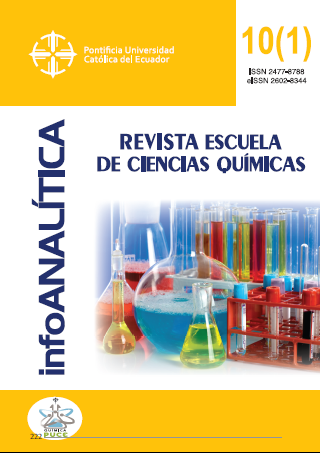QUANTIFICATION OF CHLORPYRIFOS IN AQUEOUS SAMPLES BY LIQUID-LIQUID MICROEXTRACTION AND GAS CHROMATOGRAPHY WITH µ-ECD DETECTORQUANTIFICATION OF CHLORPYRIFOS IN AQUEOUS SAMPLES BY LIQUID-LIQUID MICROEXTRACTION AND GAS CHROMATOGRAPHY WITH µ-ECD DETECTOR
Main Article Content
Abstract
The evaluation of pollutants present in the environment is a reiterative issue at the international level, for this reason the development of new methodologies for the extraction of analytes from matrices such as surface waters, with a low impact on the environment, is imperative. Chlorpyrifos (CP) is an organophosphate compound widely used for pest control, toxic to living beings, which can be mobilized from soils to different water sources. Dispersive liquid-liquid microextraction (DLLME) can be considered as a methodology with characteristics of green analytical chemistry, due to the low consumption of solvent and time. The objective of this work was to optimize the DLLME for the analysis of CP in water samples. For the extraction, methanol was used as a dispersing agent and CS2 as an extracting agent, evaluating five extraction times: 5, 10, 15, 20 and 25 minutes. The extracts were analyzed by gas chromatography with an electron microcapture detector (GC-μECD). The results of the evaluation of the stirring time showed that, for the stirring times of 10 and 15 minutes, a recovery percentage of CP of 108 and 88% was obtained, respectively, with a detection and quantification limit of 18, 3 and 22.4 μg / L, respectively, and a precision expressed as a relative standard deviation of less than 14.2%, acceptable for this type of extraction. It can be concluded that the DLLME methodology associated with GC-μECD is a suitable alternative for the quantification of CP in aqueous matrices with a low environmental impact.
Downloads
Article Details
- The authors agree to respect the academic information of other authors, and to assign the copyrights to the journal infoANALÍTICA, so that the article can be edited, published and distributed.
- The content of the scientific articles and the publications that appear in the journal is the exclusive responsibility of their authors. The distribution of the articles published in the infoANALÍTICA Journal is done under a Creative Commons Reconocimiento-CompartirIgual 4.0 Internacional License.
References
Armenta, S., Garrigues, S., Esteve-Turrillas, F. &, de la Guardia, M. (2019). Green extraction techniques in green analytical chemistry. TrAC Trends in Analytical Chemistry, 116, 248-253.
ATSDR. 1997. Resumen de salud pública: clorpirifos. [en línea]. <http://www.atsdr.cdc.gov/es/phs/es_phs84.pdf>. [consulta: 1 de octubre, 2021].
Environmental Protection Agency (EPA). 2016. “Revised chlorpyrifos preliminary registration review drinking Waters assessment”. https://www.regulations.gov/document/EPA-HQ-OPP-2015-0653-0454
Giesy, J., Solomon, K., Coats, J., Dixon, K., Giddings, J. & Kenaga, E. (1999). Chlorpyrifos: Ecological Risk Assessment in North American Aquatic Environments. In: Ware G.W. (eds). Reviews of Environmental Contamination and Toxicology, vol 160. Springer, New York, NY. https://doi.org/10.1007/978-1-4612-1498-4_1
Mackay, D. (2001). Multimedia Environmental Models: The Fugacity Approach, Second Edition (2nd ed.). CRC Press. https://doi.org/10.1201/9781420032543
Marcinkowska, R., Namiesnik, J. & Tobiszewski, M. (2019). Green and equitable analytical chemistry. Green and Sustainable Chemistry, 19, 9-23.
Márquez, S., Mosquera, R. & Herrera, M., (2010). Estudio de la absorción y distribución del clorpirifos en plantas de pasto Kikuyo (Pennisetum clandestinum Hochst ex chiov.) cultivadas hidropónicamente. Revista Colombiana de Ciencias Pecuarias, 23(2), 158-165.
Marsin, M., Umairah, S., Akmam, M. & Aini, W. (2011). Determination of organophosphorus pesticides by dispersive liquid-liquid microextraction coupled with gas chromatography-electron capture detection. The Malaysian Journal of Analytical Sciences, 15(2), 232-239.
Martínez, J., Pablos, M.C., Garrido, A. & Arrebola, F.J. (2000). Pesticide trace analysis using solid-phase extraction and gas chromatography with electron-capture and tandem mass spectrometric detection in water samples. Journal of chromatography A, 867(1), 235-245.
Martins, M., Primel, E., Souza, S., Prestes, O., Bohrer, M. & Zanella, R. (2012). Microextración Líquido-Líquido Dispersiva (DLLME): fundamentos y aplicaciones. Scientia Chomatographica, 4(1), 35-51.
Lambropoulou, D., Sakkas, V. & Albanis, T. (2002). Validation of an SPME method, using PDMS, PA, PDMS–DVB, and CW–DVB SPME fiber coatings, for analysis of organophosphorus insecticides in natural waters. Analytical and bioanalytical chemistry, 374(5), 932-941.
Lazic, S., Sunjka, D., Grahovac, N., Vukovic, S. & Jaksic, S. (2012). Determination of Chlorpyrifos in water used for agricultural production. Agriculture & Forestry, 57(11), 17-25.
Rezaee, M., Assadi, Y., Hosseini, M.R.M., Aghaee, E., Ahmadi, F. & Berijani, S. (2006). Determination of organic compounds in water using dispersive liquid–liquid microextraction. Journal of Chromatography A, 1116(1), 1-9.
Rezaee, M., Yamini, Y. & Faraji, M. (2010). Evolution of dispersive liquid–liquid microextraction method. Journal of Chromatography A, 1217(16), 2342-2357.

